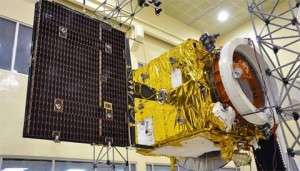On September 24th, after a convoluted, 10-month, 400-million-mile flight, India's first-ever interplanetary explorer fired braking rockets and slipped into orbit around the Red Planet.

ISRO
It's a historic day for India's maturing space program, as its first-ever interplanetary explorer successfully slipped into orbit around the Red Planet. The Mars Orbiter Mission, informally called Mangalyaan (Hindi for "Mars-craft"), became the planet's newest robotic satellite at 7:30 a.m. India Standard Time on September 24th (10:00 p.m. EDT on the 23rd).
MOM operated autonomously throughout the orbit-insertion sequence. At the time Mars was 139 million miles (224 million km) away, so radio confirmation of the craft's arrival took 12½-minutes to reach Earth. Adding further to the drama, the spacecraft was both out of view from tracking stations on Earth and hidden in the planet's shadow during portions of the engine firing.
Mission engineers and scientists, who'd gathered at the the Indian Space Research Organization's control center in the southern city of Bangalore, applauded when the main engine and eight smaller thrusters flared to life.

ISRO
They cheered even louder when Doppler shifts in the arriving telemetry showed that the craft had slowed by nearly 2,500 miles per hour (1.1 km per second), exactly as planned. The initial orbit is a looping, retrograde 262-by-47,852-mile (422-by-76,994-km) ellipse that takes 73 hours to complete.
MOM is the second craft to reach Mars this week (NASA's MAVEN arrived two days ago), and India now joins select company — along with the U.S., Russia, and the European Space Agency — to make the trek. Team members boasted that never before has a nation's spacecraft successfully reached Mars on the very first try. "History has been created today," prime minister Narendra Modi told the flight team.
Emboldened by the success of its 2008 lunar orbiter, Chandrayaan 1, ISRO's managers quickly set their sights on Mars. The MOM spacecraft follows that same basic design, utilizing a cube-shaped structure about 5 feet (1.5 m) on a side and a mass of about 1½ tons. Indian culture is imbued with the notion of jugaad — finding innovative but frugal solutions to life's challenges — and ISRO has embraced that concept. Remarkably, MOM's entire mission cost is only about $75 million, a fraction of the $670 million that NASA is spending on MAVEN.
MOM's path to Mars was not simple. After launch on November 13, 2013, the spacecraft made a half dozen trips around Earth in ever-larger loops, boosted higher and higher by repeated rocket firings. A final maneuver on December 1st pushed it free of Earth and sent it on a 10-month cruise toward Mars.
Success: Just Getting There
The mission's primary objective is not to make pioneering scientific discoveries about the Red Planet. Instead, it's simply to demonstrate the ability to design a craft capable of interplanetary travel. Science is secondary. But MOM's instrumental payload, while modest, can potentially deliver important discoveries.
A color camera will record the Martian surface. Also aboard is a photometer that will record Lyman-alpha emissions to deduce the relative abundance of deuterium in the planet's uppermost atmosphere. A spectrometer will determine the abundance of atmospheric methane — a gas at the center of a controversial debate — down to parts-per-billion levels. Rounding out the payload are a mass spectrometer (for atmospheric composition) and a thermal-emission spectrometer (for assessing surface composition and mechanical properties).
The mission is not without its detractors. Despite ISRO's jugaad-esque approach, India is a country trying to deal with endemic poverty. Still, science journalist Manoj Kumar Patairiya put the mission in perspective in a recent New York Times column. "We know how to embrace two ideas at once," he concludes, pairing "tradition and science, frugality and innovation — just as we can deal with issues like poverty at the same time as taking a giant leap into interplanetary space."
You can journey to Mars from the comfort of your favorite reading spot, thanks to our special issue, "Mars: Mysteries & Marvels of the Red Planet." It offers a timely, comprehensive look at this intriguing world next door.
 0
0









Comments
You must be logged in to post a comment.